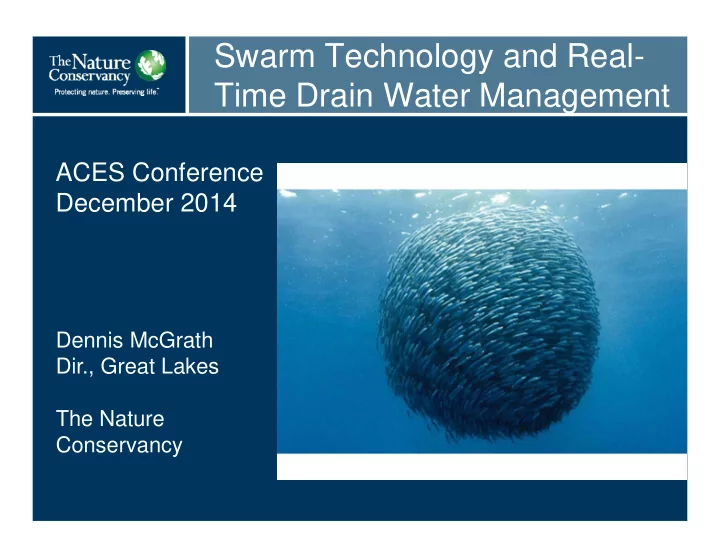

Swarm Technology and Real- Time Drain Water Management ACES Conference December 2014 Dennis McGrath Dir., Great Lakes The Nature Conservancy
Goal: Manage Ag Watershed Hydrology to Improve Ecosystem Services PARTNERS • Ecosystem Services Exchange • Agri Drain Corporation • EmNet • Great Lakes Protection Fund • Kieser & Associates, LLC • Nicholas H2O • Reetz Agronomics • The Nature Conservancy • University of Notre Dame
Ag Nutrient/Water Problems • System : Aquatic ecosystems (streams, rivers, lakes, coastal waters • Stress : Nutrient pollution • Source of Stress : Fertilizer/Manure via runoff, tiles • Strategy : Improve water flows by optimizing drainage for agriculture and clean water
Western Lake Erie Basin: 7.2MM acres 600K miles tile; 15K miles ditches Intense Concentrations Large Scale Impact
Water Flow “Drives” the Agronomic and Aquatic Systems • WLEB 2011 – Record Algal Blooms/Record Spring Rains • WLEB 2012 – No Algal Blooms/Very Dry Spring
Causes of Loss for Iowa Corn 1948-2010 Drought 40% Causes of Loss for Iowa Soy, 1955-2010 Drought 28% Excess Moisture 27% Excess Moisture 27% Charts courtesy of Chad Hart, Managing Risk in Agriculture, Iowa State University, June 2013
Drainage Water Management (Real Time) Spring Winter Seasonal Schedule Summer Fall
Drain Water Management • Proven conservation practice • Not yet widely adopted • Not managed to agronomic or environmental potential (Vast majority of today’s tile system is still free ‐ flow)
Have you wondered why……? Advantages to Collective Behavior
“Swarm” Technology • Processing many signals simultaneously to reach some collective, optimum outcome – Medicine – Water Utility Storm Systems
What if ……? Swarm Technology + Real ‐ Time Drain Water Management * Improve environmental performance * Improve crop production/ROI * Manage risk
“Swarm” RT DWM Application in Ag Watersheds Agronomic and Environmental Desired Conditions established Anticipates, Measures, Integrates, Distributes Information Manage Network of Tile Drain Outlets Farm field ‐ to Watershed ‐ Scales Optimizes Agronomic and Ecosystem Conditions
“Swarm” RT DWM Components • Real ‐ time Sensors (soil moisture, water levels, nutrients • Real ‐ time Drain Control Structures (remotely controlled drain tile units) • Optimization Program (“swarm” data processing) • Wireless Communication Network (knits together flow of information to structures)
Quantification • Optimization decisions determined by agronomic and environmental goals • Quantification allows for transactions (e.g. nutrient trading) • Quantifiable goals inform management decisions
Last Word • Field Testing – Technology – Behaviors – Agronomic and Environmental Impact (“Move the needle”?) • Scaling – Significant scale potential – Anticipate phased adoption over long ‐ term – Not silver bullet; couple with other BMP
Recommend
More recommend